Hexham’s sinister heritage!
 The 'Leper Oak' at Hexham Golf Club suggests a more sinister past for this beautiful parkland golf course.
The 'Leper Oak' at Hexham Golf Club suggests a more sinister past for this beautiful parkland golf course.
Laurence Gale MSc talks to Head Greenkeeper and former PGA Tour professional, Malcolm Lathan, about the history of the course and his approach to looking after it with just a staff of four.
Hexham is a traditional parkland golf course on fast draining land on the south side of the River Tyne almost midway between Carlisle and Newcastle. The course offers a tough enough test of golf to regularly host County events, yet at 6,400 yards from the medal tees, the 18 hole par 70 course, remains an enjoyable challenge for club golfers of all standards. The greens are regularly amongst the best in the County, and the views over the confluence of the North and South Tyne and surrounding countryside are stunning.
Built on the site of the old medieval hospice of St Giles, founded in 1114 under the care of the priors of Hexham Abbey, the "elegant Palladian house of finely dressed stone", as art historian Sir Nikolaus Pevsner describes the present home of Hexham Golf Club, belies its modest beginnings in 1892.
Until 1906, a nine-hole course ran alongside the river Tyne and was leased from the Local Board. In 1907, the new Hexham Golf Club Ltd moved up from the river to its present location. Harry Vardon, co-designer of the new course, thought it "as fine an inland course as you can find". Its 5,470 yard 18 holes were fully open in early 1908.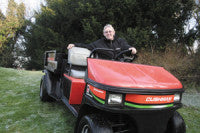
This old West Course served the club well until 1951 when it bought outright the whole of the Spital estate which included the house, now a Grade 1 listed building, and 70 acres of parkland to the east of the entrance road.
On the course there is a large oak tree, that dates back some 400 years, which is locally known as the Leper Oak because the present club house was used as a leper hospital administered by monks from nearby Hexham Abbey. According to legend the townspeople of Hexham used to leave food and supplies for the lepers underneath the oak tree.
The course, as it is now, is essentially the creation of the noted golf architect G K Cotton. By 1954 Spital House had been renovated as the new clubhouse and, together with its magnificent parkland, is now the backdrop for what Ryder Cup player Harry Weetman called "one of the most beautiful settings for golf I have discovered in my career".
Hexham golf course is maintained by a staff of five that includes the Head Greenkeeper, Malcolm Lathan. He has been at the course since 1990, the last fifteen of which have been as Head Greenkeeper.
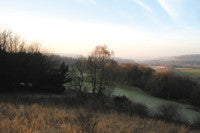 Malcolm began his greenkeeping career in the early 1970s working at Stocksfield Golf Course. He was also a keen golfer and represented England Boys in the same team as Nick Faldo in 1974. For two years he played on the professional tour alongside the likes of Faldo and Seve Ballesteros.
Malcolm began his greenkeeping career in the early 1970s working at Stocksfield Golf Course. He was also a keen golfer and represented England Boys in the same team as Nick Faldo in 1974. For two years he played on the professional tour alongside the likes of Faldo and Seve Ballesteros.
But, by the mid 1980s, Malcolm was back working on a golf course, this time at Tyneside Golf Club, before taking up his present position at Hexham. His assistant is Jimmy Richardson who has been at the club for nine years and who is also North East Section secretary for BIGGA. Geoff Mortimer (seven years service), Andrew Gunn, (five years) and recent appointment Jamie Smith complete the team.
Malcolm set up a ten-year capital budget plan for the purchase of machinery, which is bought outright. Recent acquisitions have included a Gambetti sprayer, Toro Procore 648 aerator and Jacobsen G Plex III greens mower. With such a small team operating on a fairly large undulating parkland course the main emphasis is on the efficiency and quality of mowing equipment.
The greens are soil pushed up contoured greens that amount to almost one hectare of putting surface! The composition of the greens is becoming more bent grass dominant with as much as 60% being seen on the majority of the greens. Root depth is averaging 150mm with the greens holding up well during the winter months.
Malcolm protects his greens in the winter by using temporary greens whenever the weather conditions threaten their playability, usually during heavy frost.
Fertiliser applications are restricted with the aim of encouraging better swards with finer grasses. Fairways are not fed at all, and res tricted feeds are applied to tees, usually only one in spring and one in autumn. Greens have a combination of fertilisers and some Symbio natural products to increase microbial activity, along with some wetting agents. Malcolm has reduced his nitrogen input to below 100kg per year.
tricted feeds are applied to tees, usually only one in spring and one in autumn. Greens have a combination of fertilisers and some Symbio natural products to increase microbial activity, along with some wetting agents. Malcolm has reduced his nitrogen input to below 100kg per year.
A heavy programme of aeration is carried out on tees, greens and fairways using a combination of machines including a Robin Dagger, Verti-Drain, Sisis Slitter, Toro Procore 648 and a Sarell roller. Verticutting and de-thatching is undertaken throughout the growing period to control thatch and keep the grass upright.
Greens maintenance
In March the greens are vertidrained, scarified and topdressed with a 60/40 Rufford No. 3 rootzone dressing at a rate of 1.25 tonnes per green. Throughout the growing season a programme of verticutting is carried out on a fortnightly basis.
A further two applications of topdressing are applied between March and September at a lower rate (1/2-3/4 tonne per green) with the final topdressing being applied as part of the end of season renovations in September. In total about 75 tonnes of topdressing is used each year on the greens.
The greens are then overseeded with a bent grass seed mix. Around 75kg of material is applied each year. Wear on the greens is controlled by regular hole changing at least 2-3 times per week.
Feeding programmes begin in April with an application of Terralift 8:5:1:2 NPK fertiliser. This is followed by an application of Symbio Green Circle and then, as and when required, a dose of 8:0:0. At the end of September a final feed of 5:0:29 is applied.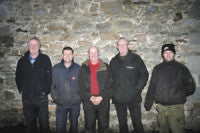
The greens are kept free of debris and dew to reduce the incidence of disease attack. Good cultural practices, reduced feeding and increasing microbial activity has reduced attacks over the past few years.
Tees maintenance
In March the tees are aerated using the vertidrain followed by an application of lawn sand to control moss. The tees are scarified and then fed with a slow release 2:0:10. They will then be aerated another five times throughout the season with a range of solid tines. A divot mix of Rufford No. 2 is made up with BSH A20 seed mix to repair any divot damage. This is applied on a daily basis.
Other maintenance
Fairways are cut twice a week - 13mm in the summer and 16mm in the winter. They are slit tine aerated six times through the winter when ground conditions allow.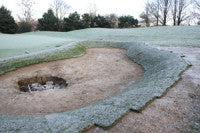
With 44 bunkers on the course renovation has been ongoing over the past few years. The team completes several each winter planning them in with other traditional winter maintenance such as path reinstatements and forestry work.
A machine is hired in to dig out the bunkers, reshaping, draining, re-turfing and re-sanding them with Devilla silica washed sand. Tillers RTF turf is used to provide a deeper rooting grass plant to help stabilise the bunker faces and surrounds.
The club has installed a Toro 3000 series automated irrigation system that serves all the greens and six tees. During dry spells Malcolm will also water by hand taking on this responsibility himself. Watering localised dry areas is often required to keep the greens in tiptop condition.
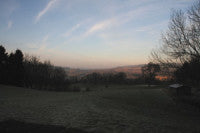 In 2008 Malcolm and his staff are gearing up for another eventful year which includes getting the course ready for the Northumberland County Championships in June. His golfing background certainly helps when setting out the course to create an interesting challenge for the golfers.
In 2008 Malcolm and his staff are gearing up for another eventful year which includes getting the course ready for the Northumberland County Championships in June. His golfing background certainly helps when setting out the course to create an interesting challenge for the golfers.
Last year the course received a Gold ranking in the Golf Monthly HSBC Regional Course Awards. In 2005 the course was presented with the STRI English Golf Environmental Award in recognition of its commitment to good ecological practices.
2007 was a difficult year for many Greenkeepers due to the unusual weather patterns and, with the ongoing pressure to provide year round golf for over 750 members along with 40 club competitions annually, the art of Greenkeeping does not seem to get any easier at Hexham.
